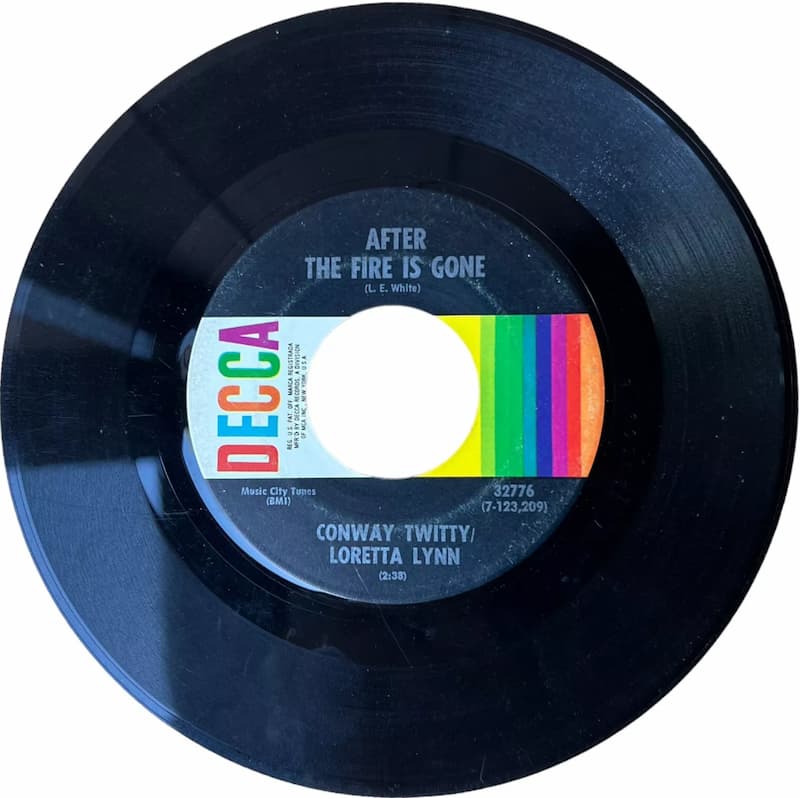About The Song
Conway Twitty and Loretta Lynn spent a great deal of time together when England hosted the first Wembley Country Music Festival in the late 1960s. While the Wembley concerts have since become huge annual events, that first one was particularly special because it marked the beginning of the Twitty/Lynn duets.
The two artists sang together often during that trip, discovering that they had similar musical tastes. Twitty swapped road stories with both Lynn and her husband Mooney and it became apparent that their personalities were quite compatible. Conway and Loretta decided to record some tracks together when they got back to the United States. Their musical styles were discovered to be close, and their voices complimented each other to a tee. They began searching for songs which might be potential hit singles.
They found their first in an L. E. White composition called “After the Fire Is Gone.” White was working for Twitty’s publishing company and he showed the song to his employer soon after writing it. Conway was initially unimpressed. He didn’t pay much attention to “After the Fire Is Gone” for about a year, then one night, at 2:00 in the morning, Twitty called White at home and said, “Boy, I’ve found this song that would be a big hit for Loretta and me,” apparently not realizing it was the same song L. E. had showed him earlier!
White had written “After the Fire Is Gone” while visiting the resort town of Gatlinburg, Tennessee. He was at a hotel which had a huge fireplace, but the fire had gone out. As L. E. and others observed this, he overheard someone say, “Boy, it sure looks cold in there, doesn’t it?” Songwriters are always on the lookout for comments or sights that might trigger a song idea, and that peculiar, off-the-wall comment about a darkened fireplace pit somehow sounded like a song to White! He thought, “There’s nothing as cold as ashes after the fire is gone.” He found a pen and jotted down the line, later building a song around that hook.
After Conway Twitty was finally on board with “After the Fire Is Gone,” they took it into the studio on Wednesday, November 10, 1970. Producer Owen Bradley considered the song’s title “tremendous – one of the best I’ve ever heard.” Conway & Loretta’s record shipped just after New Year’s. It debuted on Billboard’s “Hot Country Singles” chart February 6th and reached #1 in its eighth week on March 27, 1971, holding that position for two weeks.
Almost a year later, on March 14, 1972, the National Academy of Recording Arts and Sciences rewarded the duo’s efforts with a Grammy award for “Best Country Vocal Performance by a Group” (the Academy somehow believing that two people constitutes a “group”). “After the Fire Is Gone” marked the beginning of a string of twelve Twitty/Lynn singles with five of them making it to Billboard’s number one position, the most chart-toppers of any mixed duet in country music history.
“After the Fire Is Gone” has been recorded by approximately 40 artists including Willie Nelson and Tracy Nelson (unrelated) who took it to #17 in 1974, just three years after Conway & Loretta’s original number one version. Arguably, the best cover of the song is a rendition by Daryle Singletary and Rhonda Vincent, found on Daryle’s 2002 album, “That’s Why I Sing This Way.”
Video
Lyric
Love is where you find it
When you find no love at home
And there’s nothing cold as ashes
After the fire is goneThe bottle is almost empty
The clock just now struck ten
Darling, I had to call you
To our old rendezvous againLove is where you find it
When you find no love at home
And there’s nothing cold as ashes
After the fire is goneYour lips are warm and tender
Your arms hold me just right
Sweet words of love you whisper
But the one at home won’t fightLove is where you find it
When you find no love at home
And there’s nothing cold as ashes
After the fire is gone
After the fire is gone
